| Quotes from Mavis Malbunka, Arrenrnte
Traditional Caretaker of Tnorala / Gosses Bluff:
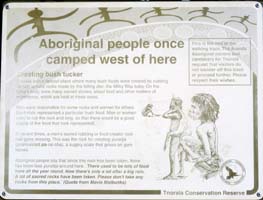
|
Tnorala was a special place where many bush
foods were created by rubbing certain special rocks made
by the falling star, the Milky Way baby.
On the baby's body were many sacred stories, about food and
other matters of importance , which are held in these rocks.
Men were responsible for some rocks and women for others.
Each rock represented a particular bush food.
Men or womenused to rub the rock and sing, so that there would
be a good supply of the food that rock represented.
In recent times, a men's sacred rubbing or food creator rock
has gone missing.
This was the rock for creating puraltja (pronounced pa-ral-cha),
a sugary scale that grows on gum leaves.
Aboriginal people say that since this rock has been taken,
there has been less puraltja around here.
'There used to be lots of food here all the year round.
Now there's only a lot after a big rain.
A lot of sacred rocks have been taken.
Please don't take any rocks from this place.' |
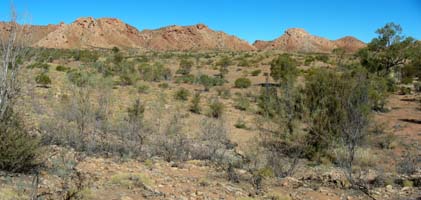
Valley where the bones were
scattered. |
Aboriginal people say that a long time ago, before white
man came, their ancestors lived at Tnorala.
They hunted, camped and performed ceremonies here.
One day, early in the morning, a man climbed up the rocks,
hunting for kangaroo.
When he came back he found all his people, men, women
and children dead, killed.
He knew that kadaitcha (pronounced ka-die-cha) men had
done it.
This man went off and told all the rest of the family,
who lived along the nearby ranges.
These people followed those kadaitcha men, who came from
desert country, to the south of here.
The kadaitcha didn't make it back to their community.
They were killed by the avenging family.
After the massacre, Tnorala became what Aboriginal-people
call a 'sorry' place: no-one has lived here since because
of sorrow over the lost family.
It is out of respect for the people that passed away here
that the Aboriginal custodians ask visitors not to camp
at Tnorala.
That's how people used ot have a battle between the tribes,
as kadaitcha man warriors.
Kadaitcha men also look after our land and our people.
This is even passed on to young children today, this skill.
Men are chosen from each family group to become kadaitcha. |
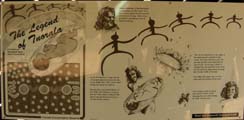
|
Here the dreaming of the creation of the bluff .....
In the Dreamtime, a large group of women danced across
the sky, as the Milky Way. They were stars taking the form
of women.
During this ceremonial dance of the Milky Way Women, a mother put her baby aside,
resting in his turna, a wooden baby carrier.
The turna toppled over the edge of the dancing area and
fell to the earth.
The baby fell down into the ground and his turna fell hard
on top of him.
At the place where it crashed into the ground, rocks were forced
up from underneath, forming the circular walls of Tnorala.
The Milky Way Baby was covered with sand and hidden
from view.
The mother, as the Evening Star, and the father, as the
Morning Star, are still looking for their missing baby. |
And here the "facts":
Geological investigations of Tnorala / Gosse Bluff indicate that
it was caused by the impact of an extra-terrestial object, probably
a comet, about 140 million years ago.
The blast has been calculated to have been about one million times
more powerful than the Hiroshima bomb.
It would have destroyed most life forms within a distance of hundreds
of kilometres and sent huge plumes of fine debris into the atmosphere,
affecting weather patterns world-wide for some years.
Craters are the main surface feature on the Moon and on Mars.
Some are like Earth's volcanic craters but most appear to have
their analogs on Earth among crypto-explosion structures of which
Gosse Bluff is typical.
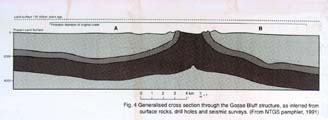

These structures have in common severe breaking up and bending
of rock layers within a roughly circular area, a crater, uplifted
rock in the centre, shatter cones, melted rock fragments, and minerals
that are formed only at extreme pressures.
Radioactive dating, using isotopes of Argon, has been carried
out on rock fragments.
This dating gives an age of 142.5 million years for the formation
of the bluff.
Gosse Bluff is one of three major astrogeological features in
central Australia. The other two are the Henbury cluster of craters,
south of Alice Springs, and the Boxhole Crater, to the northeast.
Many meteorite fragments have been found at these sites and they
are believed to be caused by a meteorite shower no more than 5,000
years ago.
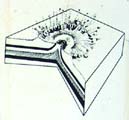
|
A massive detonation producing a shock wave
outward from the focus of the blast fits the field evidence
at Gosse Bluff closely.
Investigators (Dooley, 1991, Milton et al, op. cit.) have concluded
that the impact of an extra-terrestial object, about a kilometre
in diameter and moving at many kilometres per second, best
explains all the effects seen here.
The shallow depth of the blast suggests that the object
was a comet, or a low-density asteroid and not a solid
rock meteorite.
No trace of a comet or asteroid has been found in the area,
and it is presumed to have vaporised.
The rock layers near the centre of the blast were first
compressed and then rebounded upwards and inwards, till they
were nearly vertical. |
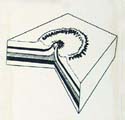
|
During the blast, fragments of rock, including blocks
up to a hundred metres long, were hurled into the air and
then fell back to the ground to form a crater about 25 kilometres
across around the impact core.
A breccia, a rock made up of shock-melted fragments, covered
the floor of this crater. |
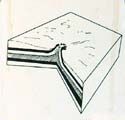
|
By 20 million years ago, a long period of erosion and
a wet climate had reduced most of central Australia to a
flat plain, with low hills where the MacDonnell Ranges are
now.
At Gosse Bluff, the outer crater rim was destroyed by erosion.
A stream flowed across the Bluff area, marked by a collection
of sandstone hills less than 50 metres high.
(Erosion is the removal of broken down rock and soil by
wind, water etc.) |
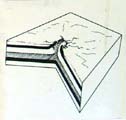
|
About 20 million years ago, a large area of land around
Lake Eyre, to the southeast of here, slowly subsided.
This has resulted in major erosion of the old central Australian
plain.
Today, the land surface surrounding the original impact
has been lowered leaving behind the near vertical rock
layers near the centre of the blast.
Sloping surfaces on the high bluff mark the old plain level
and notches mark the former watercourse. |
Amazing ..... |








